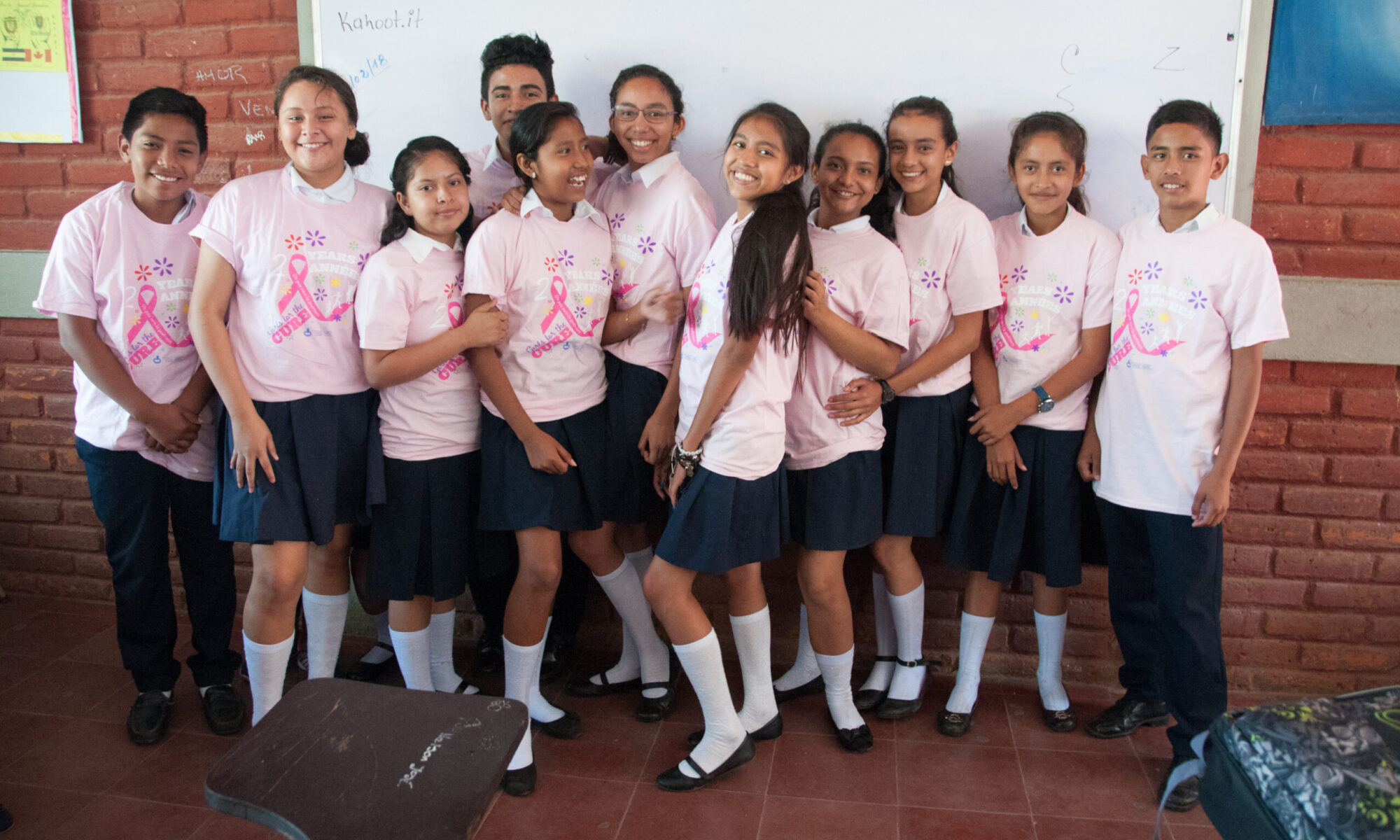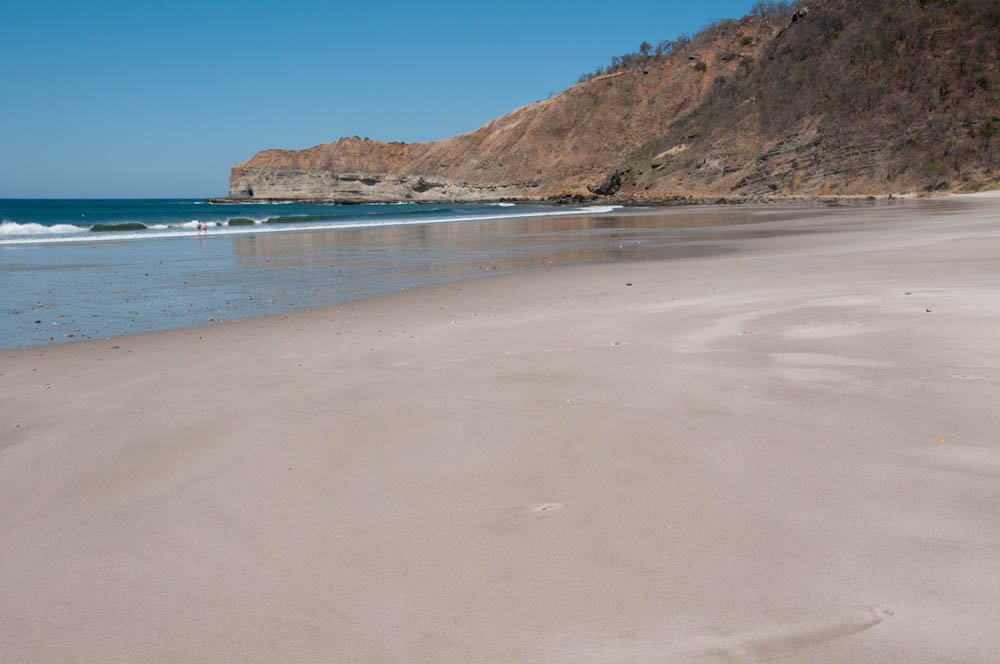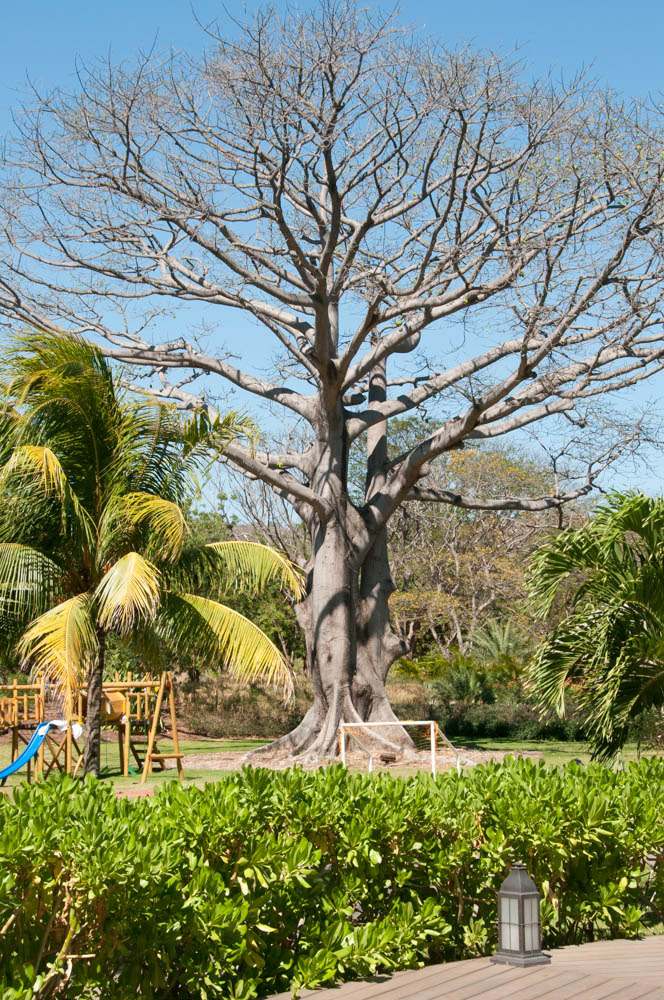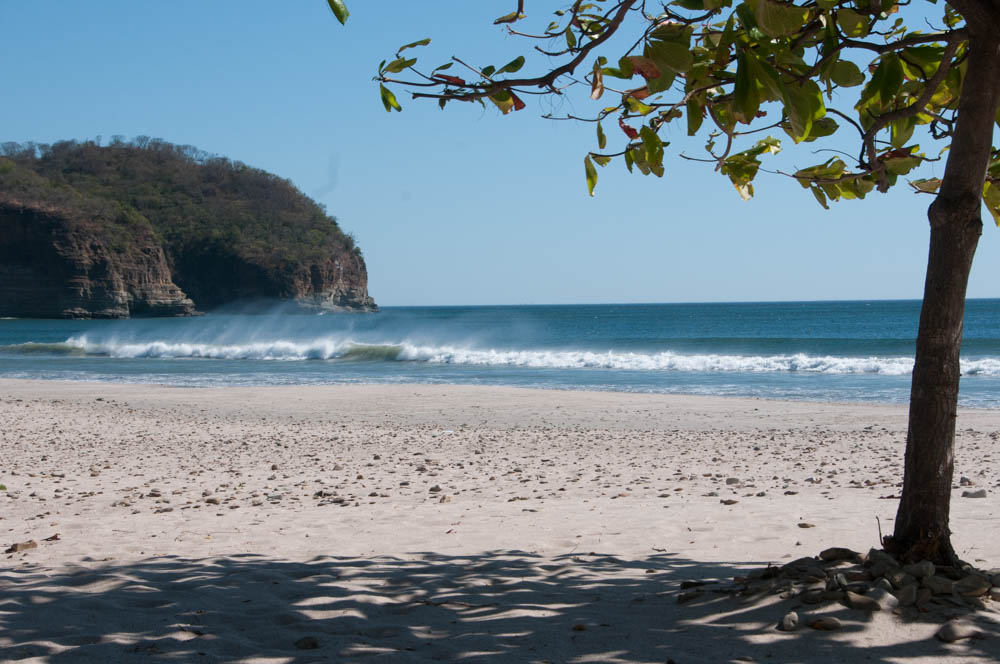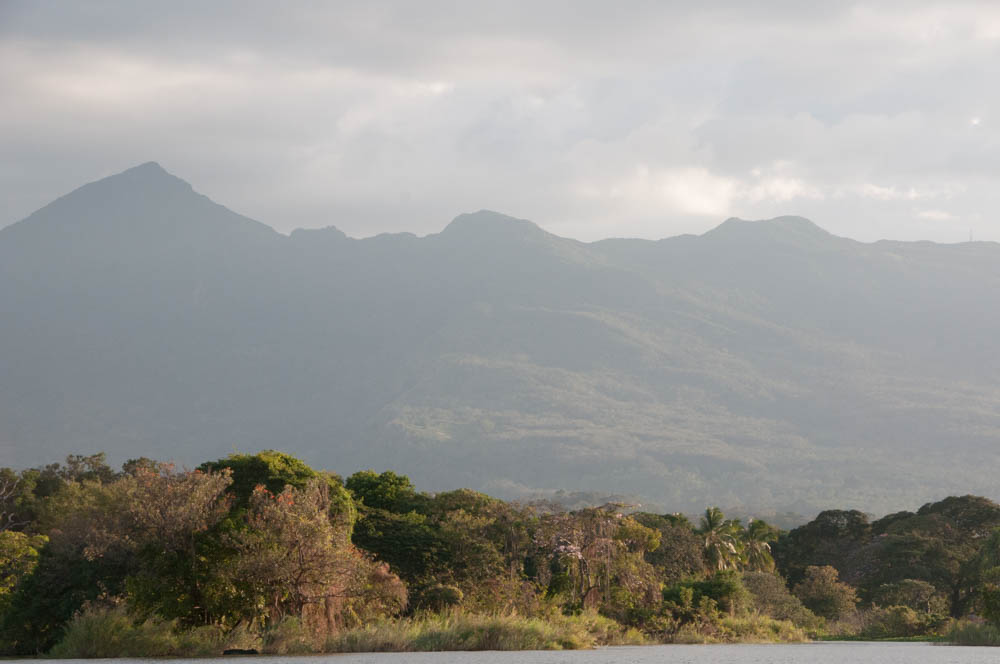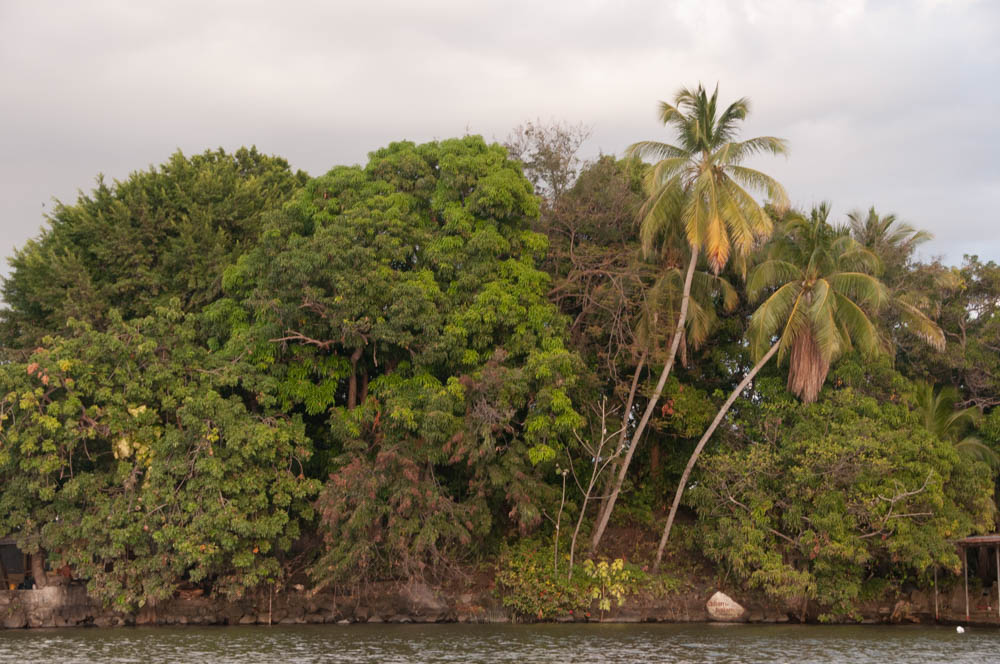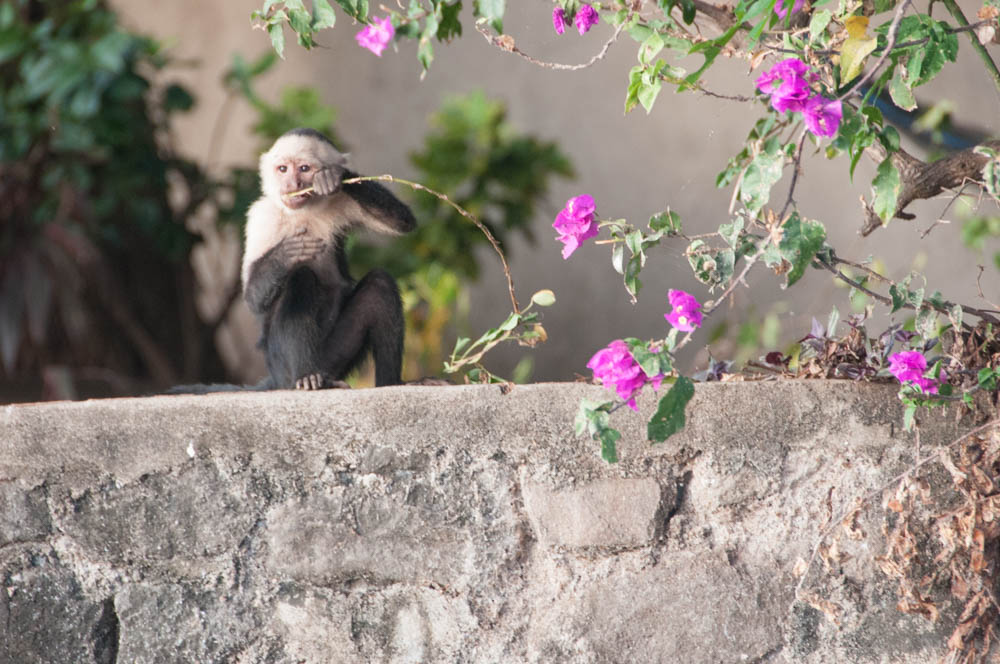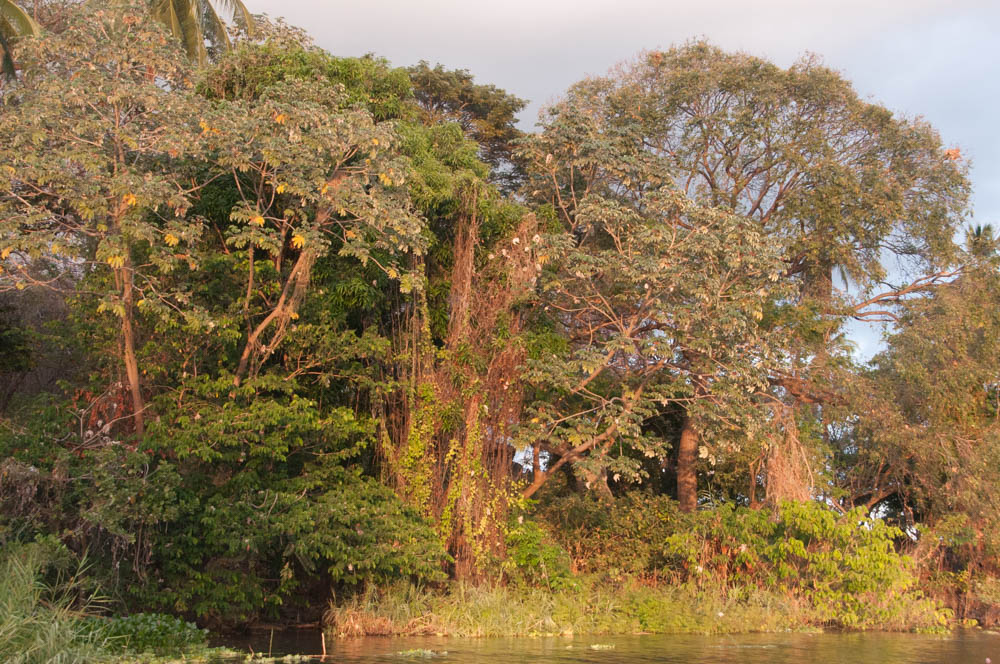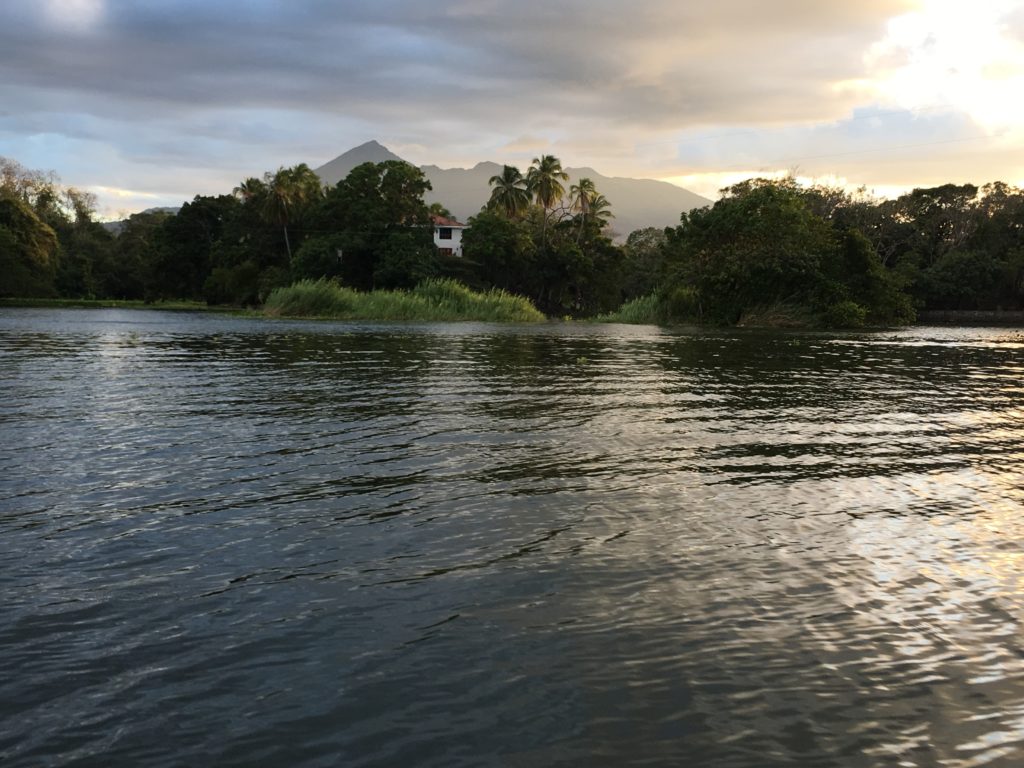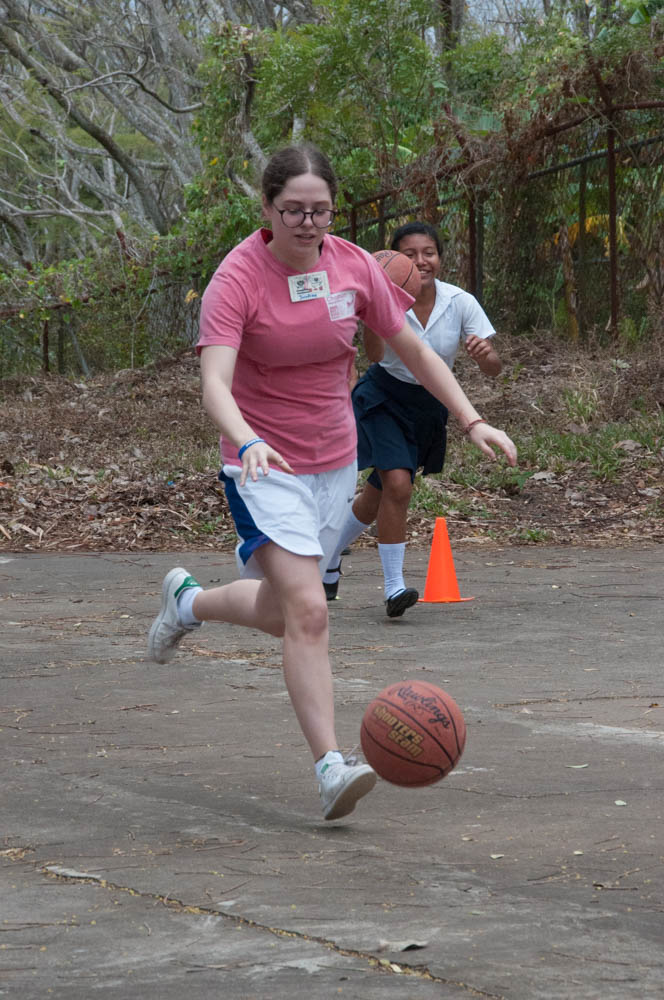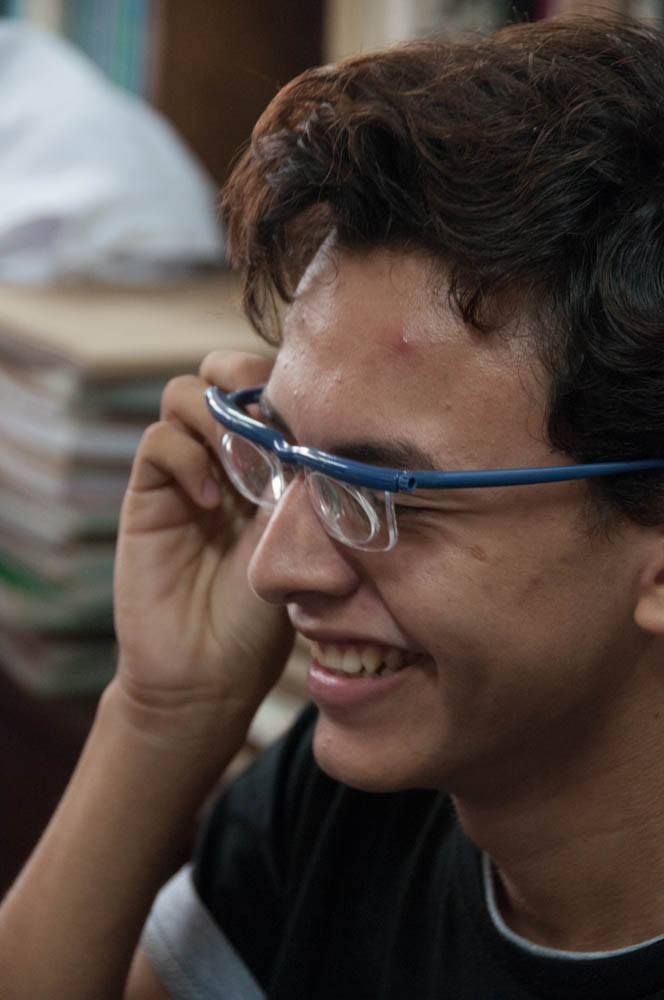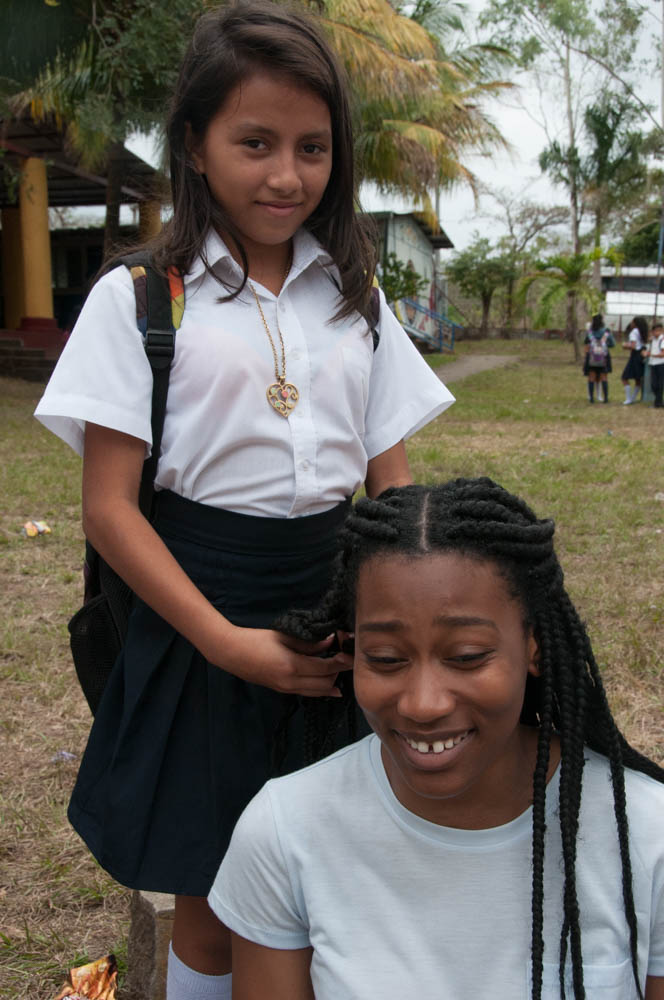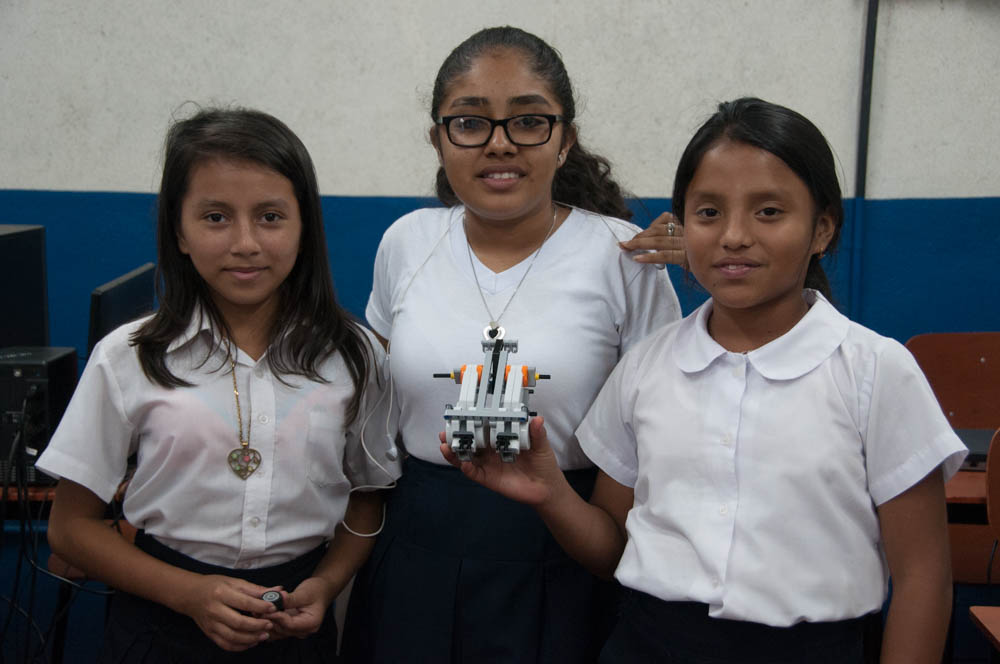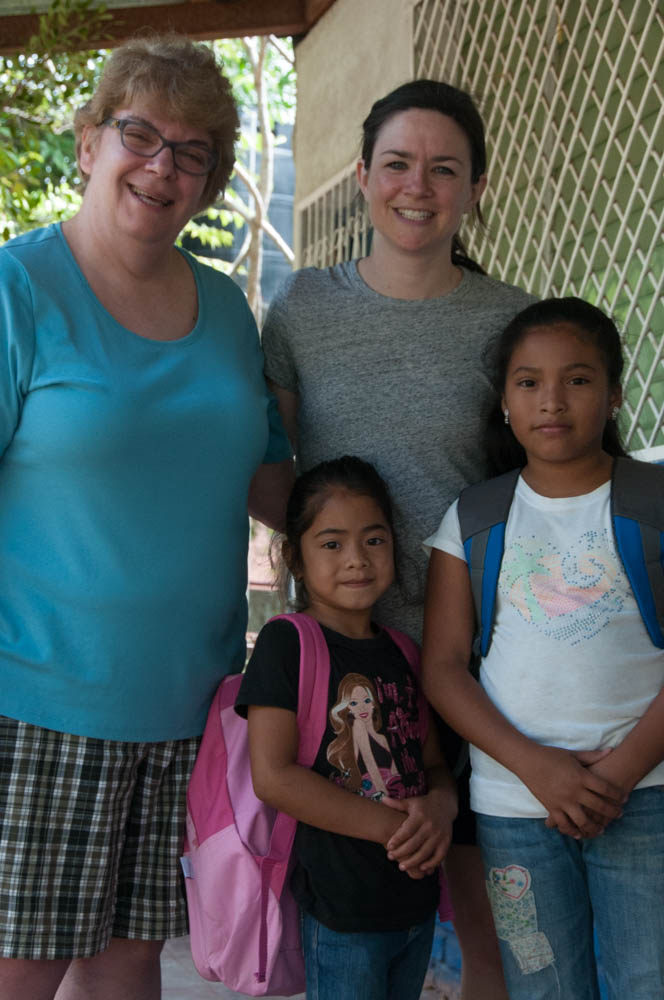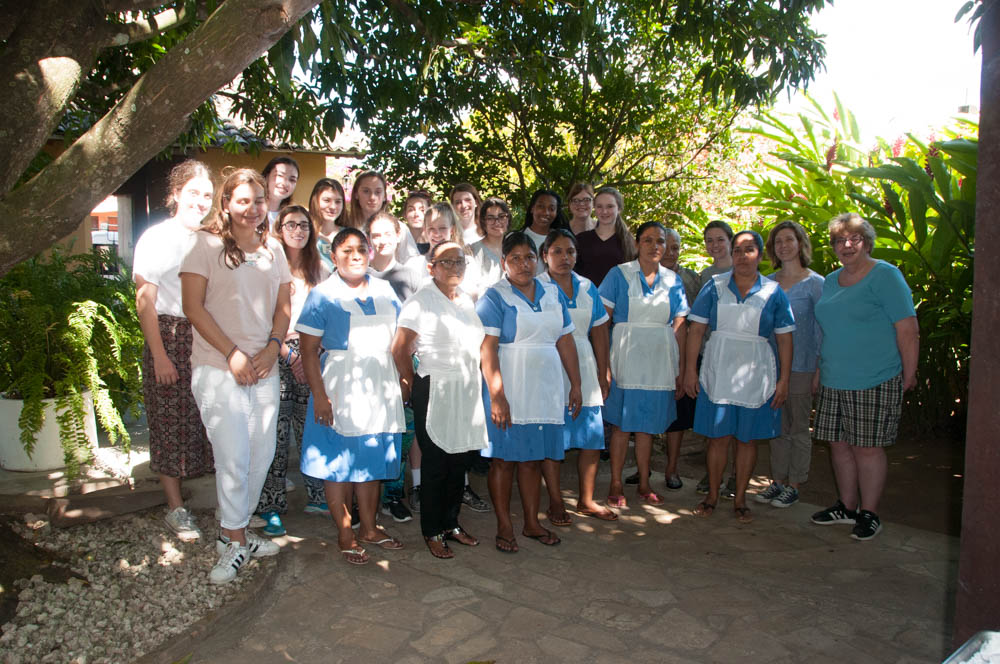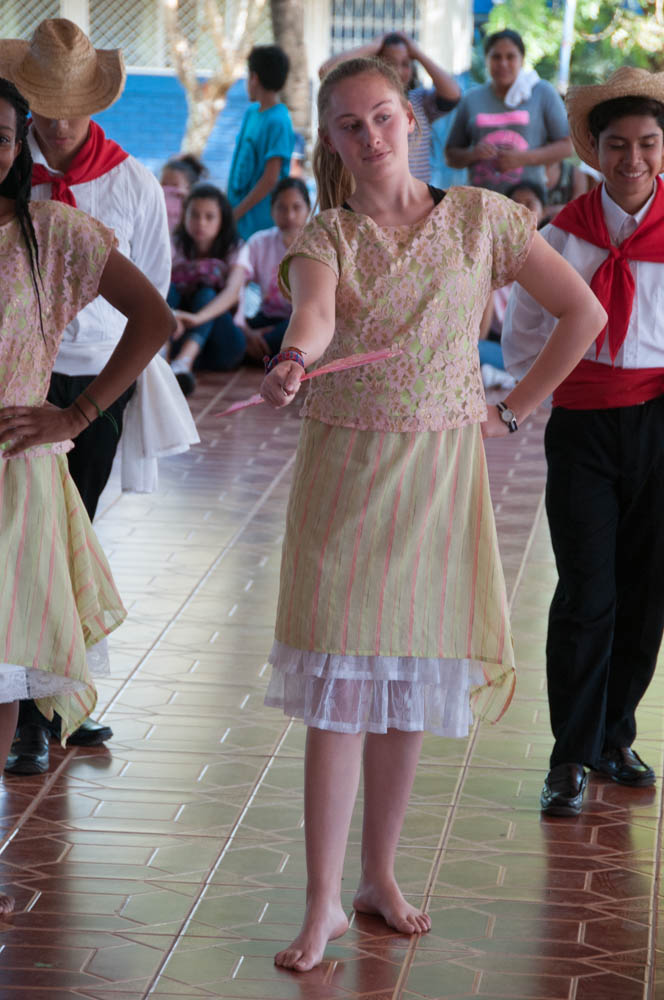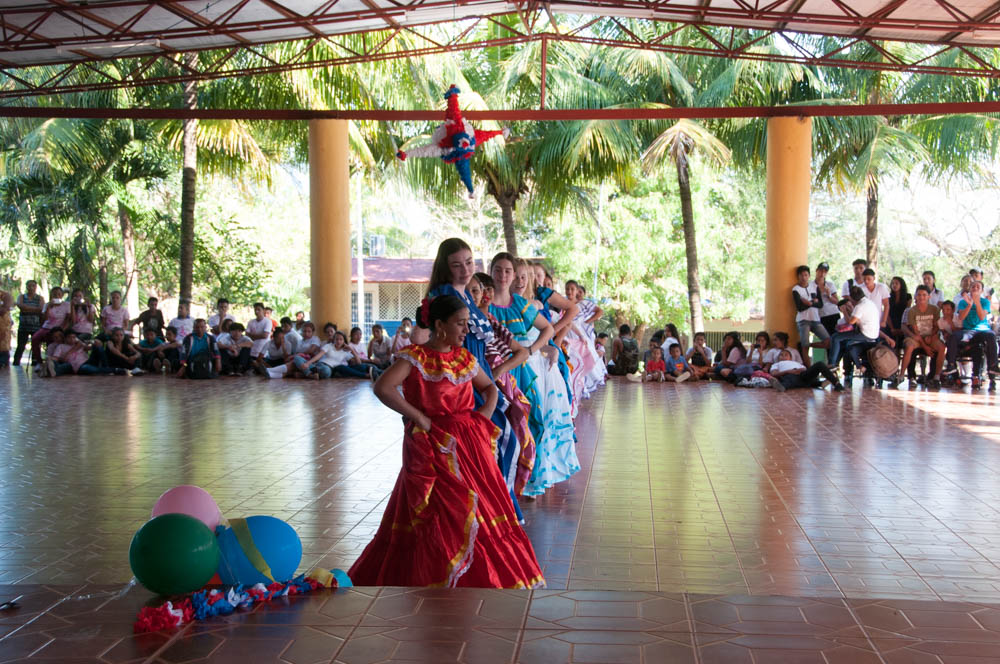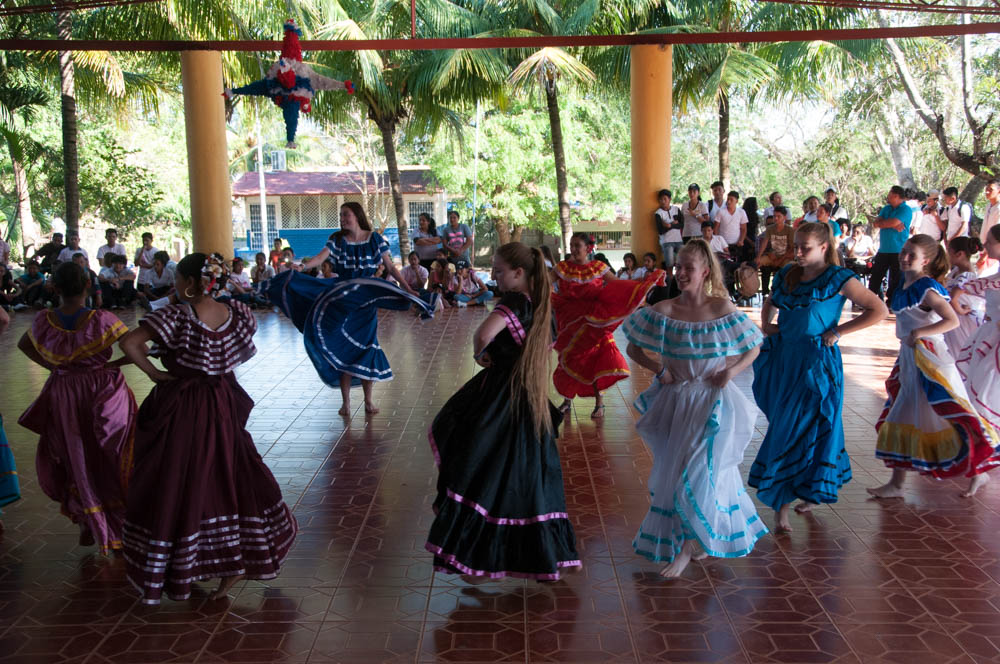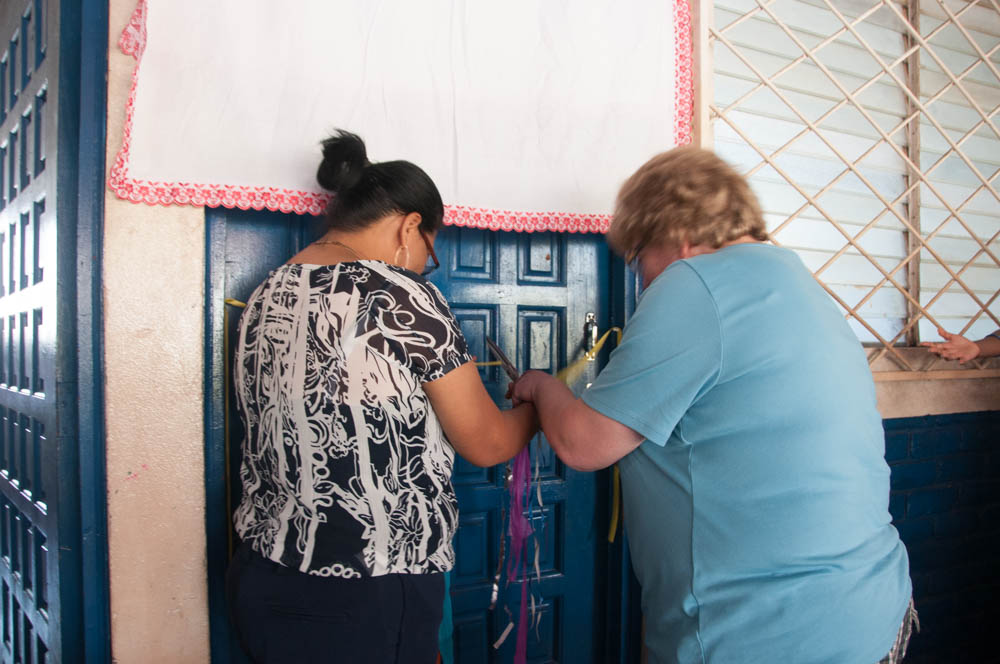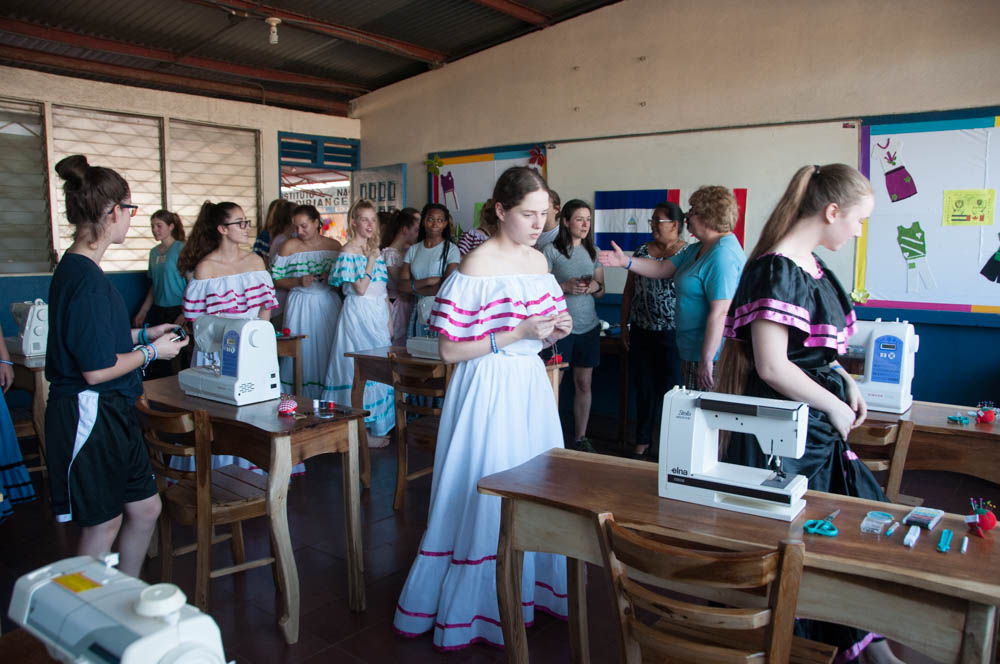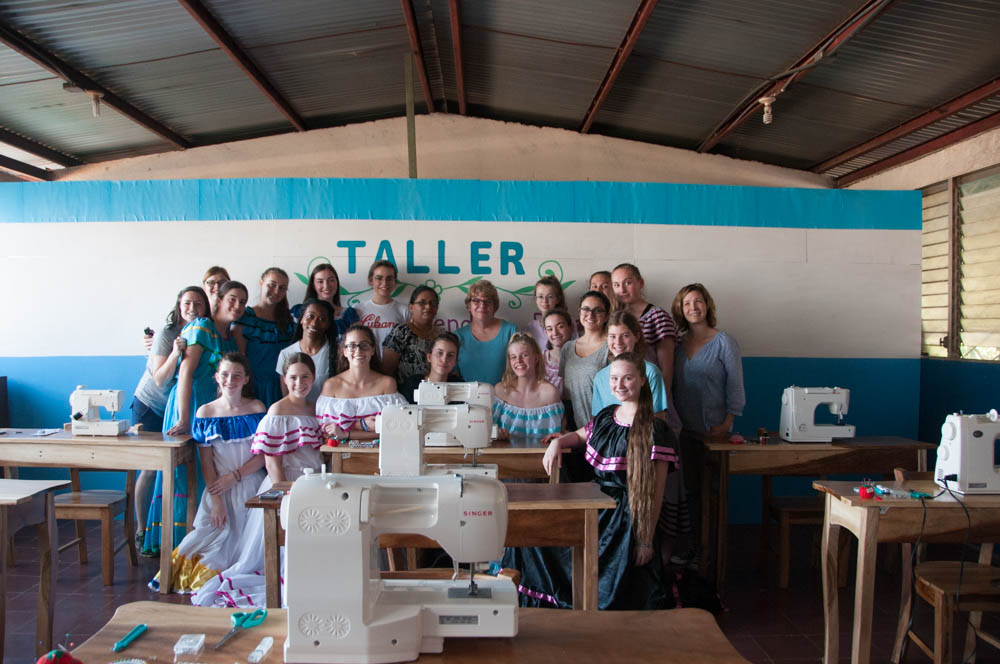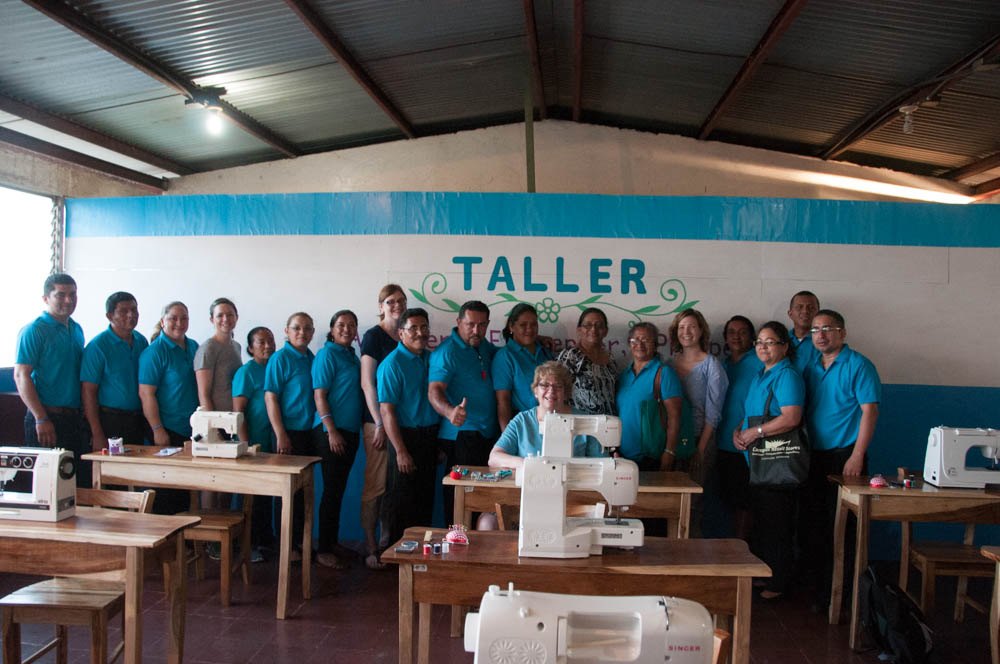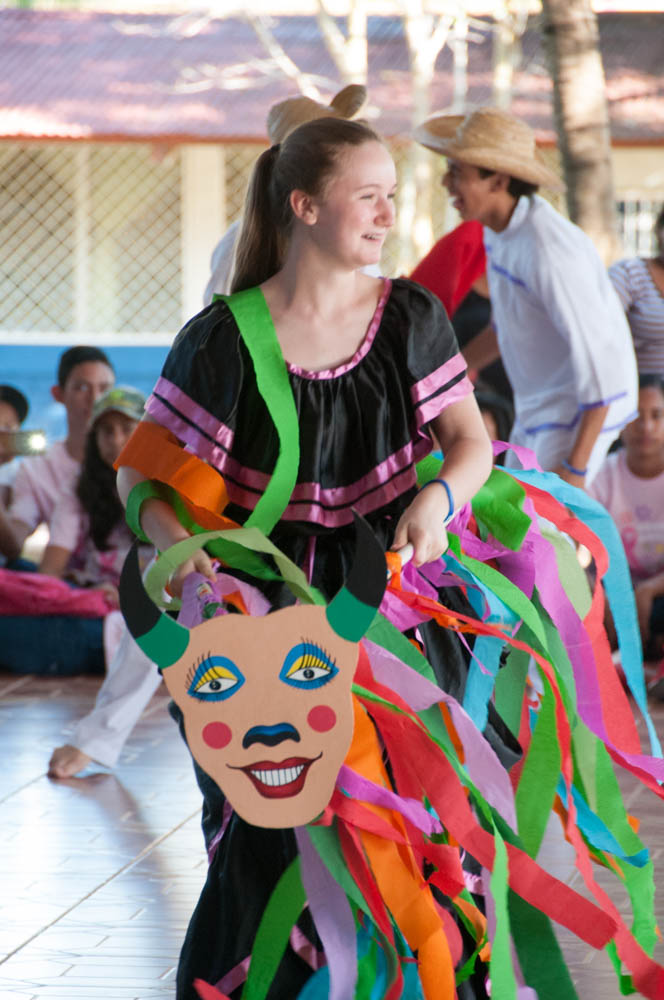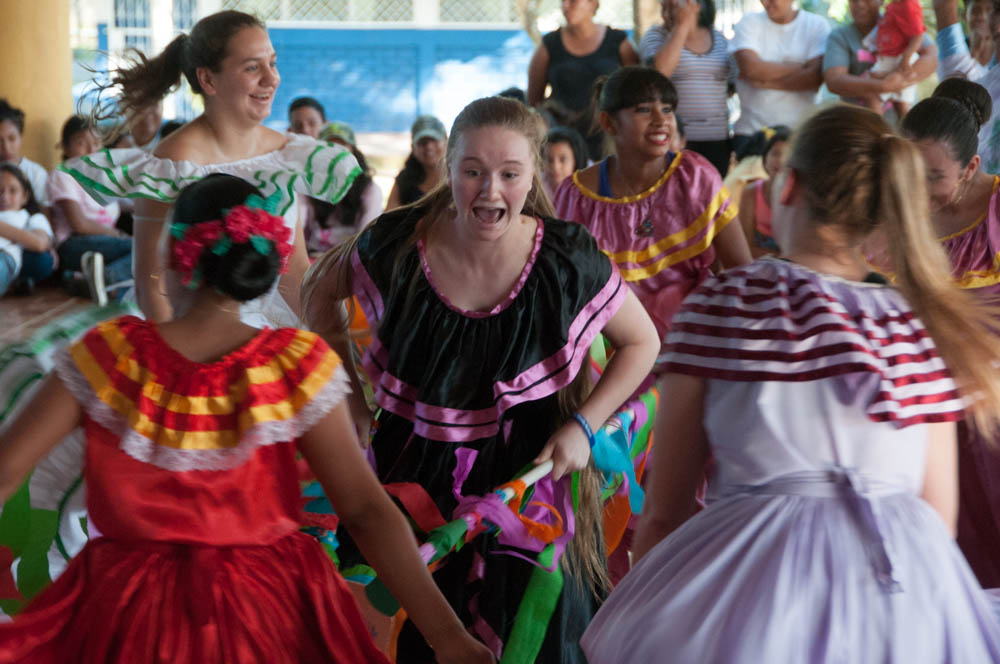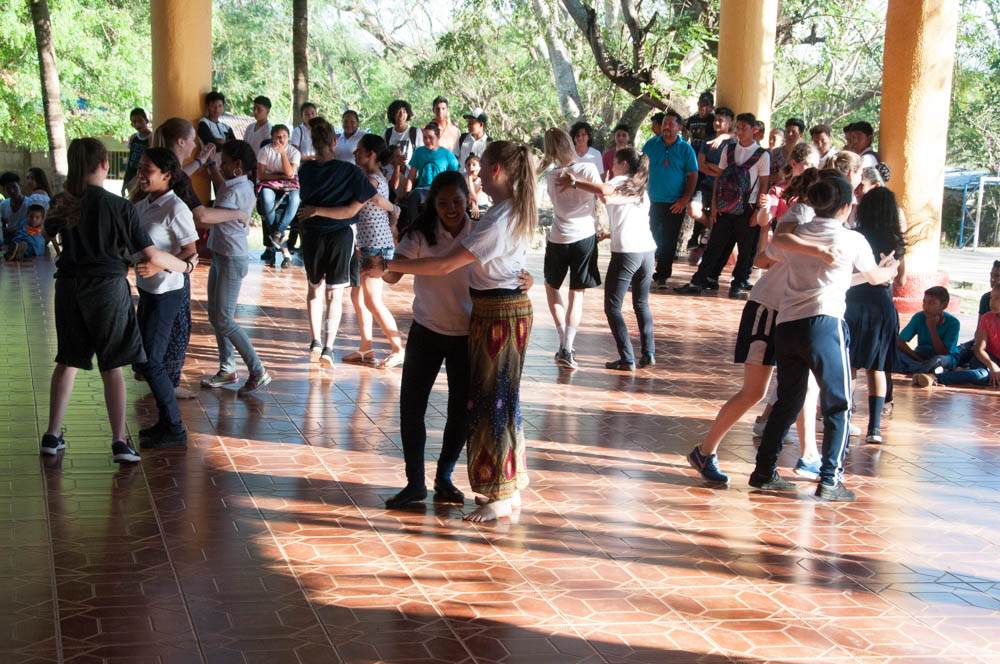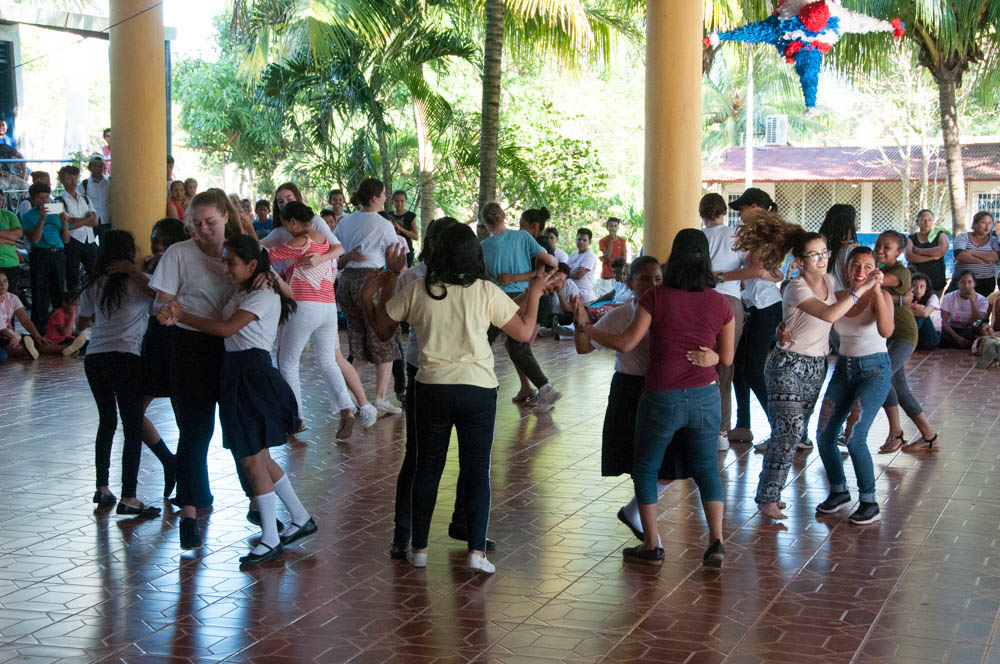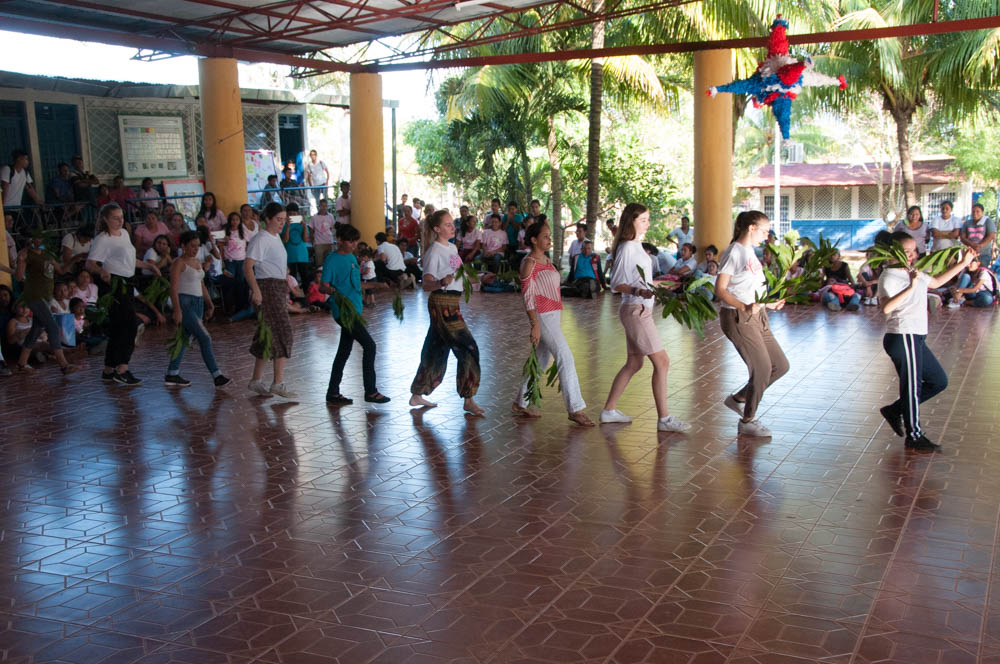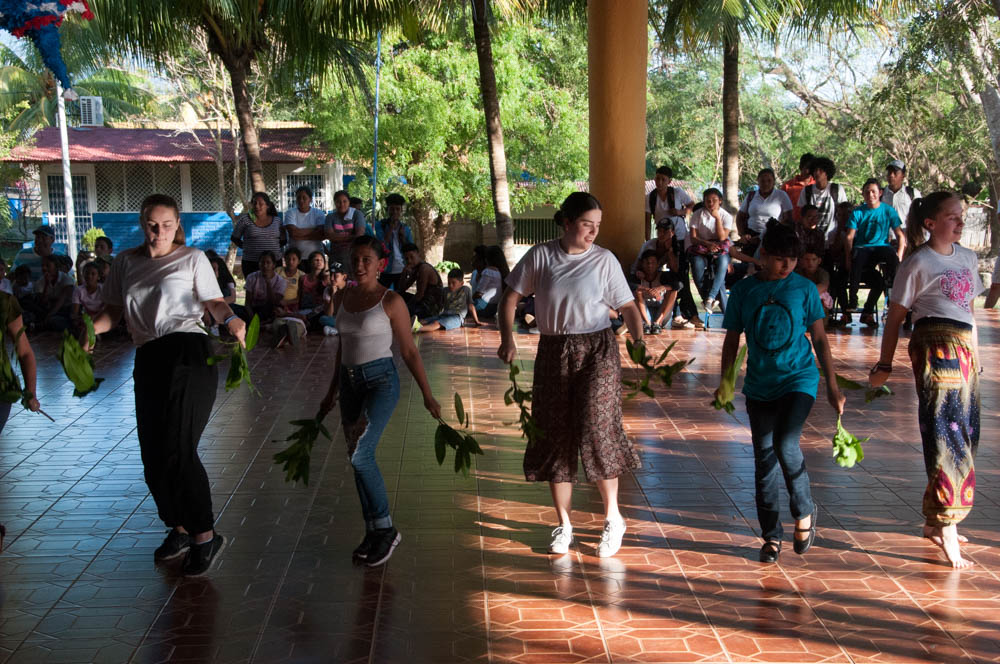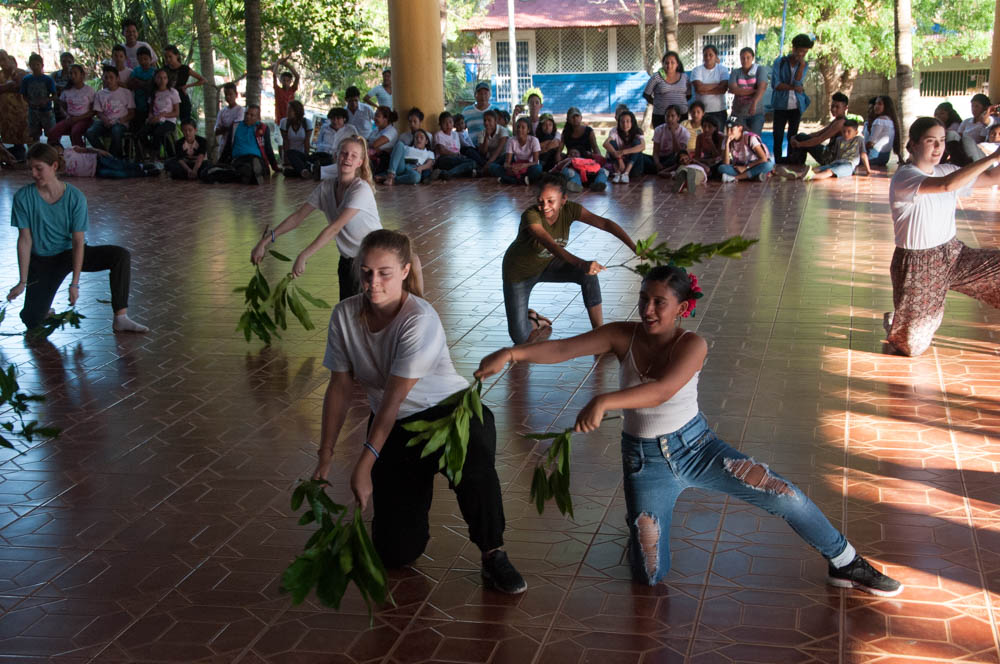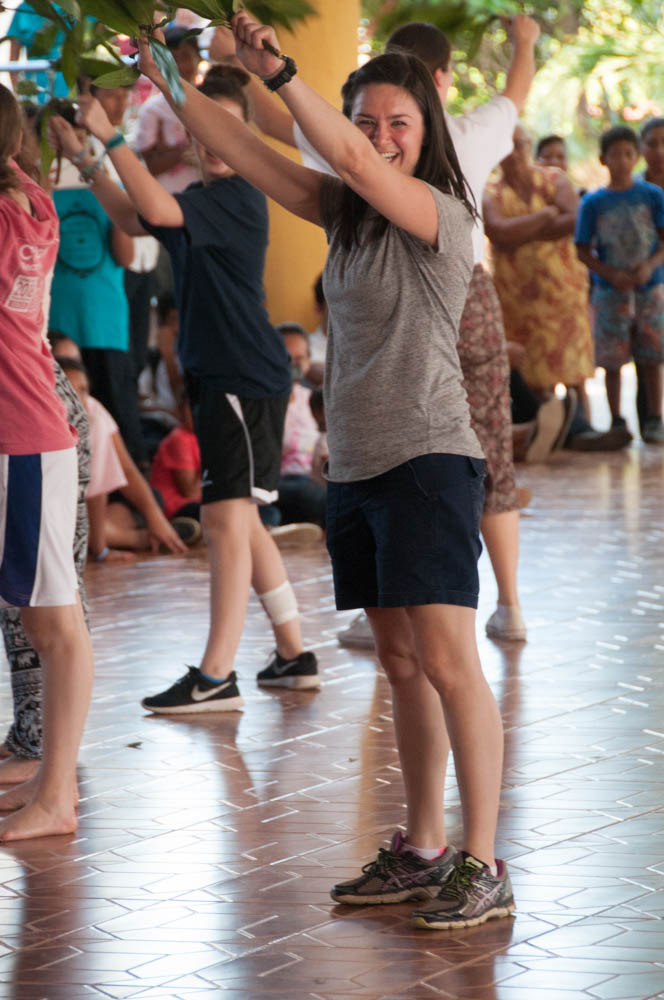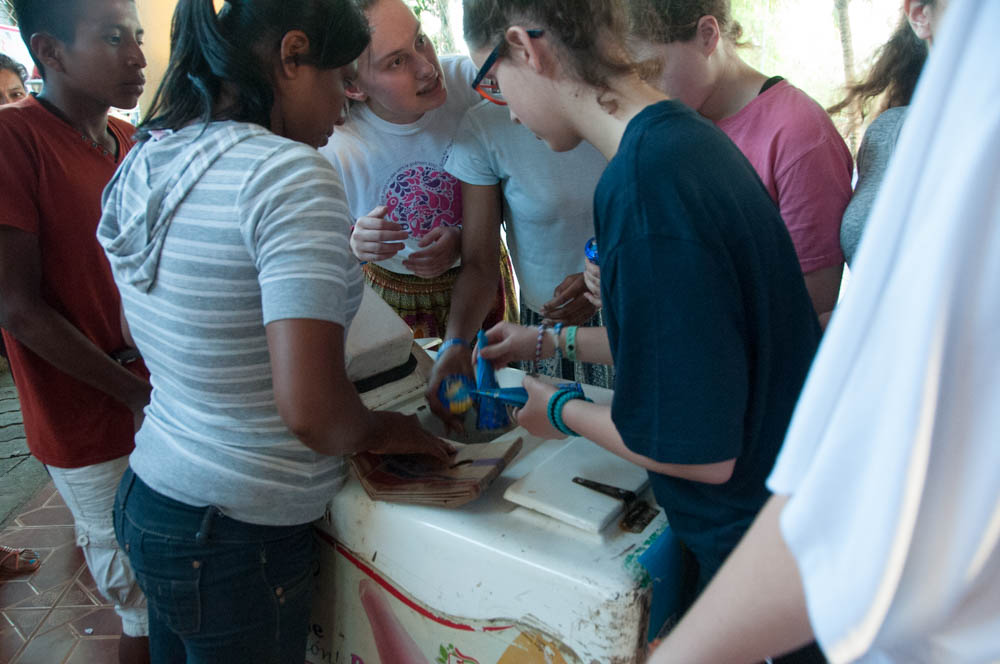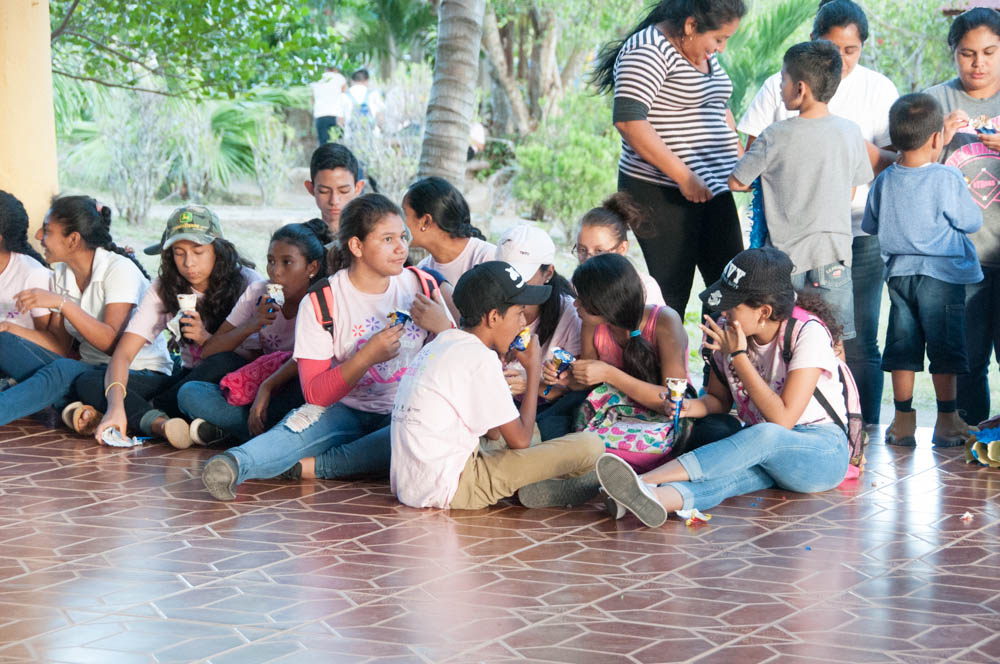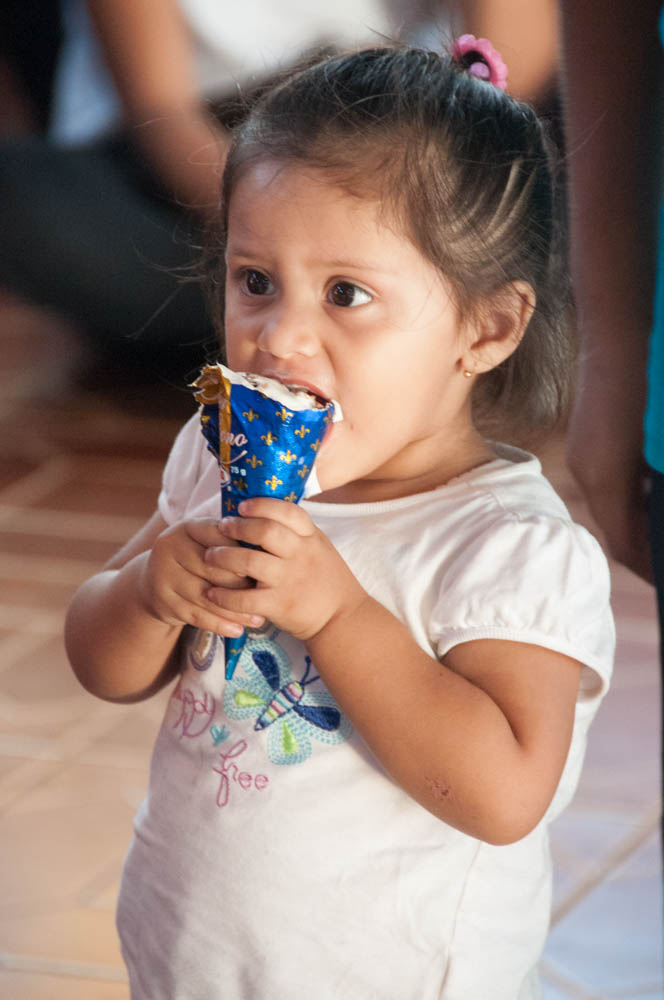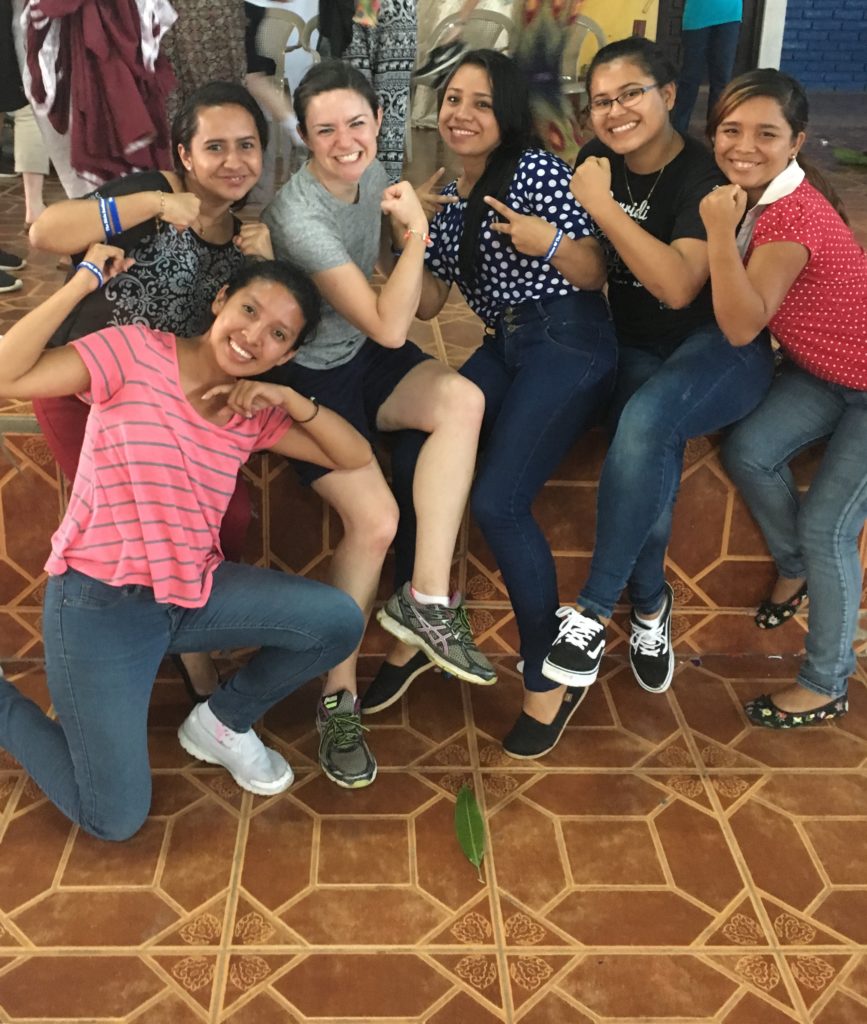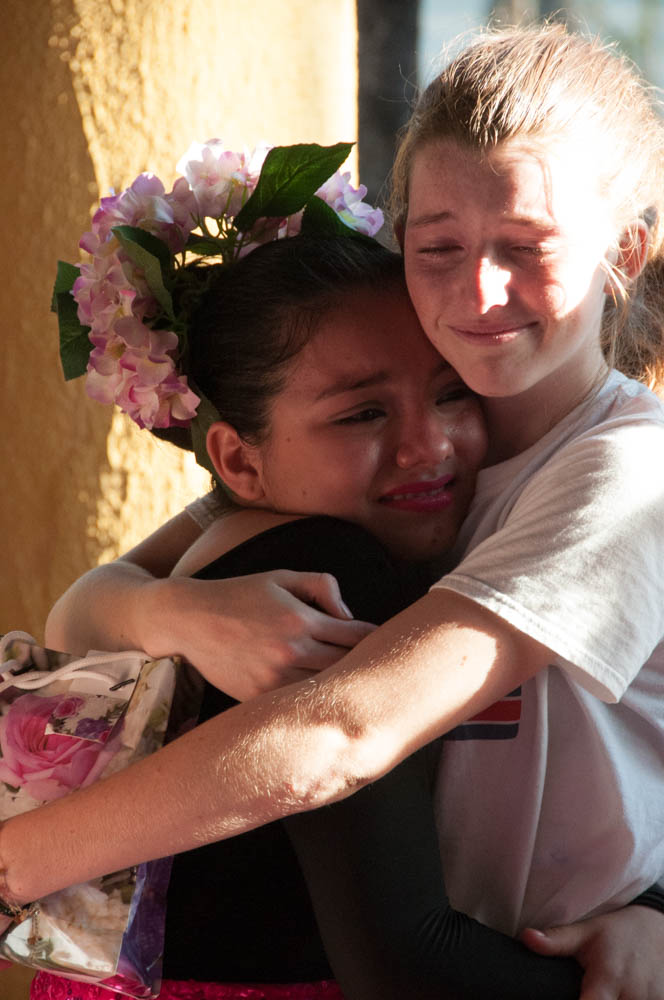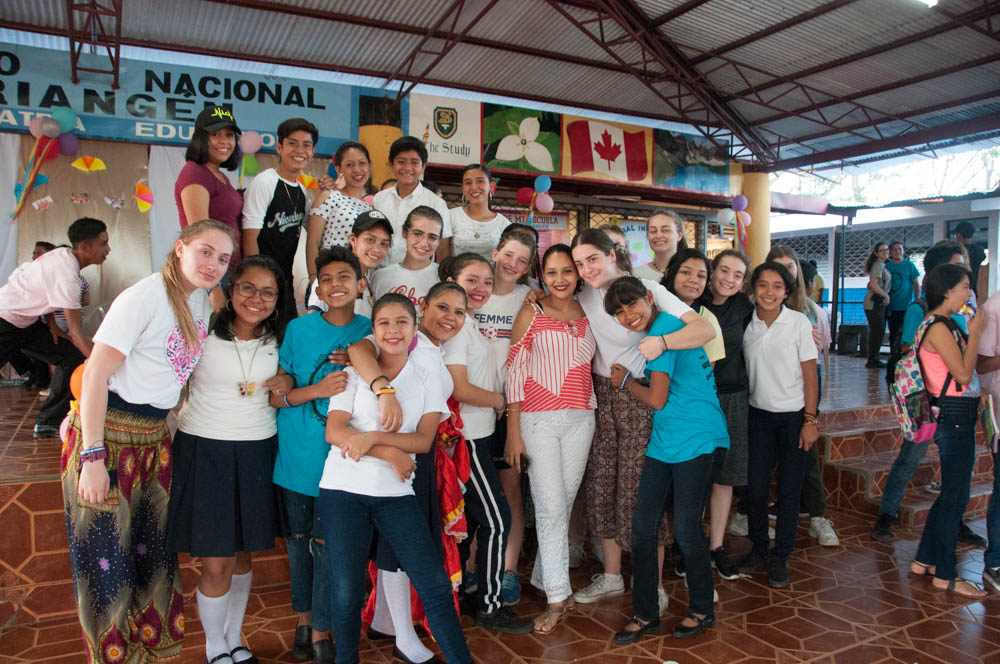Krystal:
I don’t have only one moment I can define as truly impactful. Every day of the trip I experienced something new that changed me in some way. A sight that struck me was Valeria’s house. She lived down an alley filled with many very small houses made of aluminum which can hold a large family. Her house was a room divided in two parts by a thin wooden barrier. On one side of it was her bedroom and the other side was the main living area. Each room had only a single lightbulb. The ground was made of dirt. She is such a positive and happy person, it was extremely moving and eye opening because it allowed me to put my life and problems into perspective and to really see what is important: community. I think community is so important because family and friends are what can truly make a person happy, happiness isn’t dependant on things you own, as long as you are surrounded by good people who care about you, then that is all that matters.
Sandra:
On the last day of school, this adorable kid came up to me and gave me the most beautiful hand-crafted gift. It was a wine bottle decorated with handmade Nicaraguan traditional art. I started to cry for two main reasons: 1- because it was the nicest thing ever and surprised me so much and 2- because I felt that if he lived in Montreal he would be able to pursue his passion for art and because of where he lives, he won’t get the same opportunities as someone with half his talent. Overall, I was really touched that someone with so little could give so much both emotionally and materially.
Chloe Malikotsis:
My most impactful moment was teaching the teachers of Diria Institute CPR. I was so shocked that they were so enthusiastic about learning it. One of the teachers said that her father died 19 years ago of a heart attack and if someone around him would’ve performed CPR on him, he would still be alive today. I realized the importance of teaching this skill to them because they can now teach the students, their families and any other members of the community willing to learn. With this technique, they can truly save lives.
Chloe Monty:
My most impactful moment was during the “work experience”, when we were going around to different local businesses within people’s homes. In the third home we visited, an old woman greeted us at the door. As we walked in, we could see that a giant metal machine was taking up most of her house. Her grand-children were sitting at a table in the corner of the first room. She explained to us all the different things she could make with her machine: corn tortilla, pinolillo (a typical Nicaraguan chocolate drink) and blood sausages. She was very proud to show us all the corn tortillas and blood sausages she had made for us. When she was done, we asked her how many hours she worked and how many tortillas she made in a day, but what stuck with me the most was when she introduced her great grand-daughter to the group. I noticed just how old she was when I saw that her hair was thinning and some of her teeth were missing. I realized people here do not know what retirement is. They work countless hours, every day, for their entire life. They sometimes have to quit school early in order to help pay the bills and they never get to stop. They work so hard and are never rewarded for it. I wish I could communicate to everyone here in Nicaragua how commendable their work is, and how proud they should be of themselves and their families.
Justine:
During the whole week, we spent our time at The Diria Institute. We talked to many of the students and it was so much fun getting to know so many of them. These friendships kind of even made us forget about the point of this trip at times. During the “work experience” day, we visited six different houses and saw many of the girls’ homes from the Diria Institute. Even younger girls who were in grade 7 and 8 were working with their families half the day, and attending classes the other half. The last place we visited, they were making bread and one of the girls working was a student I had seen at school the day before. She was so determined and focused on what she was doing that it was really shocking. It blew my mind how hard and serious she was working compared to seeing her at school where she seemed to be so happy to learn. You would never have known that someone with her positive attitude had to go home and work for hours, sometimes even missing school if a large order of bread came it.
Elodie:
Le moment de ce voyage qui m’a marqué le plus est les gens de Nicaragua. Tout le monde était toujours souriant et avait beaucoup d’énergie, même avec le peu de ressources qu’ils ont. Tout le monde s’entraide et trouve des moyens pour vivre une belle vie. Ceci m’a vraiment choqué car a Montréal, les gens sont très compétitifs et ne veulent pas nécessairement aider les autres et voir les autres succéder même avec toutes les ressources que nous avons. Personnellement, je crois qu’on devrait prendre exemple de la communauté de Diria en voulant aider les autres.
Camille:
My most impactful moment occurred during our last day at the Diria Institute. After saying my goodbyes and seeing Ms. Liogas giving everyone the sign that it was time to leave, I headed toward the bus with teary eyes. As I was descending the steps of the stage, someone tugged on my pants. When I looked down, a young Nicaraguan girl wearing a pink and grey striped shirt met my gaze. I dropped to my knees and hugged her as her tear-stricken eyes dampened my sleeve. We backed away from each other and I held her hands as we peered into each other’s eyes. She didn’t say anything but I could tell that this little girl I had never met before today had somehow been touched by our presence in her school. I had never before realized that this experience in Nicaragua was as impactful for the students and community of Diria as it was for us. I truly believe I am leaving Nicaragua with a different perspective of the world and the different experiences of the people living throughout it.
Jamie:
My most impactful moment on this trip was seeing the scholarship winner’s houses, one in particular was Valeria’s house. We had had a lunch with these girls the first weekend we arrived, and you would never have known, or even suspected the conditions these girls are living in. Walking into these houses (if you can even call them that) made me stop and open my eyes to their reality. This was so much harder than I ever thought it would be. Hearing them thank us from the bottom of their hearts for this scholarship with the warmest smiles was so inspiring as these girls are working with no-thing. Valeria’s home couldn’t even fit all of us, Candelaria slept on a plank of wood, Iveth’s dad has kidney problems putting all the responsibility on her and her mom, Estefania walks 5km to the bus stop every morning (after sleeping only 2-3 hours) and so many more difficult situations… Hearing and seeing this first hand has forever marked me, and I will always remember what true dedication and hard work is thanks to these wonderful women.
Emily:
My most impactful moment was when I talked to this little girl who was sad because we were leaving. I asked her if she thinks she is going to go to college and she shook her head. I then asked her if she was going to apply for the scholarship and she nodded. Her eyes were so big and bright, beaming with potential. I told her to study and work hard as she clung to every word I was saying. This scholarship is a beacon of hope for many of these girls. It made me realize that even though it is only awarded to one girl, the scholarship positively effects the entire community. Side note- This trip has been so rich in experiences and self-realizations, but it also allowed me to bond profusely with the other girls on this trip in an inexplicable way.
Lily:
The one moment, or at least the first that really impacted me was hearing about the two young girls who weren’t able to go to school because they couldn’t afford the $30 each. That amount is for their school supplies, uniform and shoes, which are required to be able to attend school. It would also make sure the older one who would be in grade 7 doesn’t get shipped off to work in Costa Rica with her mom. I didn’t experience this first hand but heard Ms. Rosenbaum tell us about it during the nightly debrief we had called, “Roses, buds, and thorns”. It made me cry for the first time during this trip. It completely took me off guard and made me realize how much I take my education for granted. Not only were they overjoyed after Ms. Rosenbaum and Ms. Liogas decided to pay for them, but they both registered for school two days later. This story completely changed my life and perspective on things forever.
Carolanne:
The whole trip was very impactful and to narrow it down to one moment is extremely hard. The moment I choose is the state of starvation of the animals. It just proved how much veterinarians are needed. Seeing a dead horse on the side of the road was devastating. I cried so much! This proved to me how poor the civilization actually is. It showed me how starving everyone is. Even if the students are exactly like us personality-wise, they go home to completely different lives. Unlike us, these students don’t go back to a house full of food. They are born into these situations that no one should ever have to live in. The real moment of realization of how bad everything really is, was demonstrated through the animals I saw.
Michaela:
During the entire trip, I was able to observe a completely different way of life such that it is difficult to pick just one moment that was the most impactful. However, one of the most impactful moments that shocked me was our visit to Iveth’s house. Contrary to other scholarship winners’ houses, Iveth had the “luxury” of having concrete walls and a tile floor. Even though she had this, her father had been very sick and needed surgery a couple years back. Up to this day, just to be able to survive, Iveth’s father needs to take 15 different pills each day. Since he cannot work, Iveth’s mother has had to work two jobs just to cover medical costs and her daughter’s education. However, she would not have been able to afford going to university. When we visited Iveth’s house and spoke to her and her parents, we all felt extremely emotional and it made many of us realize how much this scholarship can change someone’s life. Education is crucial and it makes me very happy to know that Iveth will one day have a steady job and be able to support her family.
Caroline:
The most impactful moment of the trip was seeing how grateful and excited the scholarship winner were about the opportunities the scholarship has given them. When we went to Estefania’s house, she gave a gift to the teachers and I was in awe because she had so little but still wanted to give them a gift. Also when we went to Iveth’s house she told us she was doing it for her mom, so she wouldn’t have to work. These two girls showed me they are such kind-hearted, giving girls, and they deserve all the opportunities in the world. In Nicaragua, I saw so many talented people with so much potential, all of the kids at the school were so skilled at sports, dancing, and art and I feel they just need to be given the opportunity to fulfill their potential and they would all go so far in life. They all deserve so much and even being able to see us give these opportunities to fulfill their potential is so heartwarming and I know they’ll all go really far and do good with the opportunities they were given.
Marcella:
Throughout this entire trip, we were shown improvements that had been made to the Diria Institute because of The Study. On the Thursday, we went to another one of the schools in the area called Anne Frank. We didn’t get to spend a very long time there but in the few very superficial looks I got into the classrooms, you could already see the huge difference between this school and the Diria Institute. Seeing the juxtaposition between our school [The Diria Institute] and a “normal” Nicaraguan school was probably my most impactful moment because though the Diria Institute still has a long way to go, in the last 10 years it’s already become so much better. Visiting Anne Frank made me so happy for the kids at the Diria Institute but it also filled me with a want and need to help all of the schools of Nicaragua so that every child can get a proper education and opportunities to improve their quality of life. Education is the most important aspect in improving one’s life and I wish that all the kids could have this opportunity.
Isabel:
The most impactful moment during this trip was seeing Bernarda; a past scholarship winner. She graduated university a couple of years ago. She came to see us at the Institute to talk for a couple of minutes. She told us about how she applied for a three-month temporary administrative position at the Managua hospital. She got the position, and when her three-month contract ended, she was given another three-month contract. After that, she was offered a permanent position. The reason this was so meaningful to me is because it truly showed how much of an impact the scholarship has. Bernarda now has a steady job because of her education. She is able to support her family and is creating an amazing future for herself. She’s also helping her family for future generations. She has a well-paying permanent job, meaning she can send her children to university, helping them also have a better future. I think it’s amazing, that although we’re only sending one or two girls to school at a time, we’re actually helping the entire community; both now and in the future.
Lauren:
My most impactful moment was definitely when we were saying our goodbyes on the last day at the school. Being a part of their assembly, dancing with them and exchanging gifts with our buddies was an amazing experience that I will surely never forget. Even after a super emotional goodbye with my buddy, it still hasn’t hit me yet. It wasn’t until a little girl that I had never even met before came running towards me and hugged my legs, did I understand exactly what I was leaving behind. It was so much more than just a hug to me because it reminded me just how kind, welcoming and absolutely amazing all of these people are. It also made me think about how this little girl, who was so full of life, probably won’t have the chance to get a proper education. I know that it seems like a lot to get out of one tiny hug but I was so overwhelmed by the wave of emotion that came over me and all that I had just processed that I actually started to cry. I had gone nearly 7 full days without really understanding the big impact we were making, not only in the school, but the community as well. It kind of all clicked in that one moment. After about a minute, I could feel her shaking her head against my legs so I bent down only to realize that she was crying as well. It was probably the most emotional moment of my life because I think we just sat in each others arms crying for a good 5 minutes before I realized that I had to leave. Strangely enough, I felt much better after our moment because I knew that if we continue our efforts into bettering the education of these kids, little girls just like her would get the opportunity to have a better life and that’s what this trip was all about to me.
Vivian:
Choosing one specific moment to write about has proven to be a lot more difficult than anticipated. Everyday we spent in Nicaragua, surrounded by the kindest, most loving people I have ever met, opened my eyes to something new. Funny enough, the moment I’ve chosen to write about is one that reminded me of home. On our second to last day at the Diria Institue, we opted to walk alongside our buddies (who by the way were some of the brightest and warmest women I’ve ever had the pleasure of meeting) to Estefania’s home; one of our past scholarship winners. The walk itself was nice and gave us time to bond with our buddies. An hour and a half later, we arrived. Estefania started by telling us how incredibly thankful she was for the opportunities the scholarship had given her. Every time we visited a past/present scholarship winner, things would get pretty emotional. Estefania was explaining to us how difficult it already is to attend university, even with our help. She’s trained her body to live off between 2-4 hours of sleep every night. She needs to be up at 3:30 am to make it to school on time. While trying to process everything that Estefania was saying, my focus quickly stopped when her little sister came running and sat with her. I don’t really know how to describe exactly what it is I felt seeing that little girl but the second I saw her, my entire body was swamped with sadness. This little girl looked identical to what my own little sister used to look like. Same hair, same skin color and same face. They even shared an identical scar underneath their left eye. After I made the connection, I could not stop thinking of one thing. This little girl who reminded me so much of my very own little sister will probably not get to attend university just because of where she was born. This seems a bit selfish but picturing Sabine in the position that of that little girl just made all of this so much more real for me. There are so many bright, young women like my wonderful buddies and Estefania’s little sister. They all have so much potential to impact the world in the most positive of ways but probably won’t be able to just because of where they were born. It broke my heart to be completely honest. It really made me realize how unbelievably fortunate I am and how I need to use that to make a difference. The students in Nicaragua, and I believe I speak for everyone when I say, showed us a kind of love and warmth I’ve never experienced from anyone else in my life. They all deserve everything in the world and I now know that I want to do everything in my power to assure them of that.
Beatrice:
A day after we have returned from our adventures in Nicaragua, I reflect on what has most impacted me this time around. On this year’s trip, we made a conscious decision to connect by disconnecting. On day one, the teaching team bought a backpack and collected all electronic devices including phones, tablets and ipods. It was beautiful to see students talking at supper time and during our moments in the bus. This created a group that was cohesive, empathetic and interested in their shared experience. This also allowed them to connect faster and more meaningfully with their peers at the Diria Institute. Connecting with others is what drives human behaviour and on this trip I was glad to see how much mobile technology (or the lack of) affected our capacity to capture important moments that will possibly change our outlook on life.
Sarah:
How is it possible to condense an eleven-day trip with 17 incredible students and three amazing colleagues into one “most impactful moment” blog entry. I have been reflecting on what I want to write about since Ms. Liogas made her request, and quite honestly, it has been an extremely difficult task. I experienced so many meaningful moments while in Nicaragua – and even though it is not my first time on this trip, it once again altered my perspective on life.
I spent time last week in a class being taught by Profesora Ioanna, the language teacher at the Diria Institute. The day before this class, Profesora Ioanna had attended a professional development session given by Ms. Liogas on the use of computer-based educational learning platforms for all subjects and languages. During class the next day, Profesora Ioanna started the class with YouTube videos about verb endings then used a Kahoot! multiple choice “game” to test the students understanding of the verb tenses covered in the videos. Another important point to point out is that for the first time, Profesora Ioanna was using the iPads that we had brought down for the school. So between the iPads and some cell phones, the students were all able to access the Kahoot! program. Watching the facial expressions of the students as the class worked its way through the 8 questions was one of my memorable moments. The expressions of joy when a student got the answer correct, and the expressions of “really, I didn’t get the right answer” were just like the expressions I see on my students’ faces. What really resonated for me was that the students at the Diria Institute and the students at The Study are similar in all ways except for one, and that is that the students at the Diria Institute haven’t been given the same chances in life as the girls on the trip from The Study.
Thankfully, our partnership with the Diria Institute provides the students with chances, the availability of technology and teaching supplies for the classrooms, professional development opportunity for the teachers, the chance to apply for and receive a university scholarship or the newly established vocational center which will provide students with skills to better their lives. Seeing first hand that our partnership with the Diria Institute is changing lives is my most impactful moment of the 2018 Nicaragua community service trip.
Jennifer:
I think for me the most impactful moment was finding out that a little grade seven girl hadn’t been attending school because she could not afford shoes, a uniform or materials. She lived near the school and had missed the first three weeks so far. When we found out the cost of sending her to school was $30, we didn’t hesitate to arrange to have her academic journey supported. I couldn’t believe the difference $30 could make in that little girl’s life. It’s one thing to know how lucky I am to have been born in the city I was, and to have grown up in the family I did, but to have such a specific monetary comparison was really eye-opening. What is $30? A meal? A shirt? A nice bottle of wine? For this 12-year-old it was the difference between obtaining an education or not. Education can give her options which could lift her and her family out of poverty, all for such a menial cost. The principal, being the passionate woman she is, walked straight over to her house to bring her in for a chat. The offer brought to the table was if she continued to attend school every year, then at the beginning of each school year, new shoes, uniform and materials would be provided for her but it was up to her to work hard and make sure she attended her classes. Her eyes lit up briefly, only to look away with awkward hesitation. The principal asked her why she was hesitating and as she looked down at her shuffling feet admitted she had a younger sister at home that she had to take care of, who was also not attending school for the same reasons as her. Her younger sister should have been in grade one. This resounded even deeper thinking how much responsibility must lay on this young girl’s shoulders. Upon hearing this, we extended the offer to her younger sister as well to ensure both girls would be given the same opportunity. The principal and the young girl left again to go get the younger sister and bring her in to take both their measurements. As soon as that 6-year-old walked through the door she immediately crawled onto my lap and gave me the warmest smile I’ve ever seen. Both her and her sister seemed to be a mix of shy, curious, and excited all at once. We didn’t have a ruler small enough to measure the younger sister’s feet so I traced her foot on a piece of paper to send with the shoe maker to ensure the right fit. I asked the older sister, Rayza what she wanted to be when she grew up and she almost immediately answered that she wanted to be a lawyer to help people in need. I wonder what world she lives in for that answer to have come so quickly in her mind. Certainly not what my 12-year-old self would have answered. The last day we were at the Diria Institute, both girls and their mom came by to collect their uniforms, shoes and materials. After posing for picture with their new backpacks, their grinning faces stepped onto a taxi to complete the registration at the Elementary School. Today we received pictures of each of the girls, in their crisp new uniforms, new leather shoes, and backpacks, on their way to their first day of school. The only thing that gives me a deeper sense of purpose is knowing the scholarship program that is in place is now something for these young, resilient women to work toward, something that can change not only their lives, but their families, and the beautiful community of Diria one day.
Amalia:
As the person who is the coordinator of the Study’s Nicaraguan initiative, I wanted to take this opportunity to add my own reflection. First off, I wanted to highlight the generous contributions made by The Study community. This is our sixth trip to our sister school and over the years, 85 Study students have had the opportunity to experience this life changing, exceptional student experience. Every year we pledge to improve our sister school in Diria. Since 2010, we have bought classroom sets of books, built and outfitted a science lab, brought technology to the school and the list goes on. This year we are embarking on a multi-year school improvement project. We are creating an entrepreneurial center which will allow students who do not receive our scholarship to have an opportunity to learn a vocation which might one day help them lift their families out of abject poverty. When I spoke to the parents’ committee earlier this year, I explained what our vision for the Diria Institute was. Our goal on this trip was to set up the sewing section for our vocational center. Right away, I received countless donations of items dealing with sewing, knitting and crocheting. Each student who embarks on this community service trip brings a second suitcase filled with donations. The suitcase itself is left at the school as a donation. When we were coming up short on suitcases, a parent stepped in and bought us 7 suitcases. When I needed a gift for the teachers of the Diria Institute, a parent generously donated a gift bag of cosmetics for each teacher. Water bottles, caps and knapsacks were bought by various parents as gifts for the students that our students are partnered with. When I came up short on our shoe fund, where we buy shoes for the poorest children of the school, a parent told me not to worry and that I would get the money before I left. We were able to buy 85 pairs of brand new shoes for kids in need. This initiative is truly a full school community project. Each year, the generosity and kindness shown by everyone amazes me.
Even though I am the coordinator of the project, I have a team of teachers who are working tirelessly for the Nicaragua partnership and with whom I could not do any of this. Team Nicaragua, as I call it, consists of Sofia Essayan Perez, Dr. Paola Perez, Antonia Zannis, Sarah Howard, Beatrice Bousser, Mona Bosnakyan, Jennifer Rosenbaum and myself. And of course, without the support and leadership of Nancy Sweer, this project would not be possible.
I also would be remiss if I didn’t thank the so many sponsorships we received this year. The Moulton Grant allowed us to buy 5 new sewing machines (along with the 4 sewing machines that were donated) and 9 tables and chairs for our new vocational center. Sparkfun.com supplied us with $700 which allowed us to supply our sister school with much needed electronics. Promolink.ca donated 500 pencils so that we were able to give each student a pen, pencil and a Girls for the Cure t-shirt. First Lego League donated two robotics kits.
Going to School Should be a Right and Not a Privilege
For this last blog entry, I’ve asked the girls to write about what impacted them the most on this trip. For me, I can’t narrow it down to one moment but to a series of moments. Hearing about how two young sisters could not go to school because they could not afford to buy shoes or a uniform just broke my heart. No six year old should ever have to worry about not being able to learn how to read and write and not knowing where their next meal was coming from.
Sisters Jadeth and Rayza on their first day of school (grades 7 and 1)
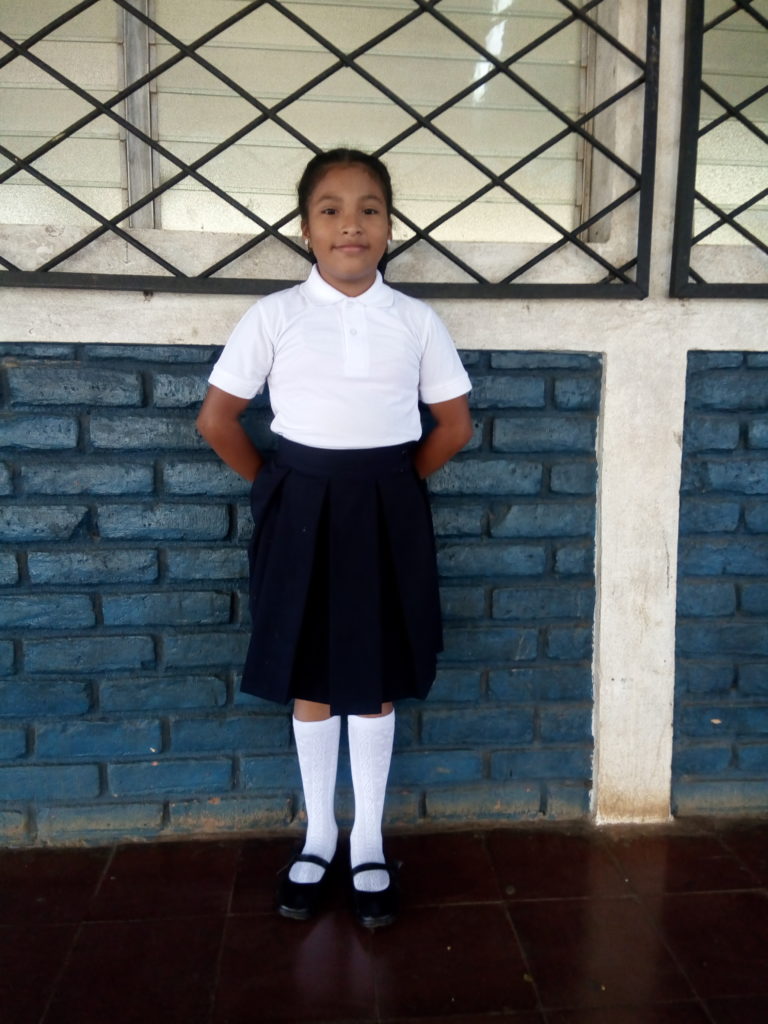
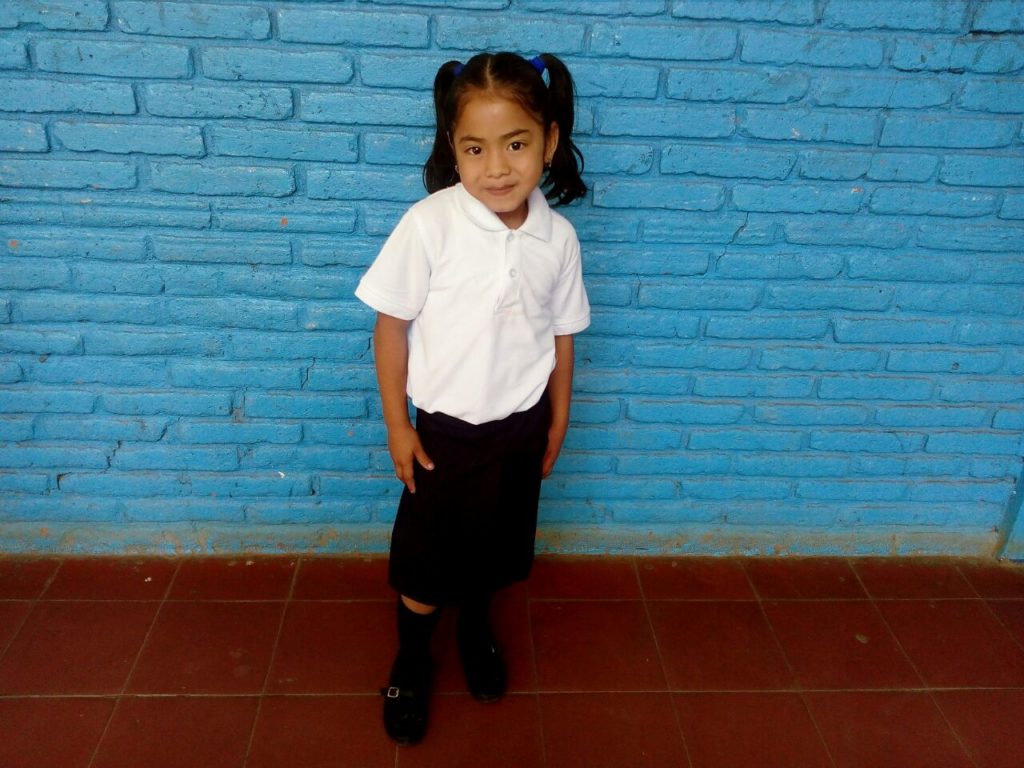
Poverty
I believe in teaching our students that to understand someone, you have to walk a mile in their shoes and yet some miles have proven harder than others. Even for myself, as a mature adult, I find myself unable to process the level of poverty in which some of these young women live. I still can’t fully comprehend the extreme poverty that Candelaria lives in. Candelaria is our 2016 scholarship recipient. The Study offers a full scholarship to a graduating female student of the Diria Institute to go to university. The scholarship is for $5000 US and covers their 5-year undergraduate degree including tuition, transportation, books and lunches. Students at The Study are responsible to raise the funds needed to send these girls to school. They also choose the recipient of the yearly scholarship award. In order to apply for the Study scholarship, girls are judged on academic promise, community service and economic need. When we go over the scholarship applications, I tell the Study girls on the committee, that all the girls applying are poor. On our end, we are trying to determine the degrees of poverty. As we have discovered over the years, the girls in our program that are better off are the ones that have a cement floor, bed, stove, fridge and roof over their heads. Of all our scholarship winners that we have had over the years, only one girl has been “better off”. Estefania must walk 5 kilometers just to go to a bus stop. Iveth is working night and day so that she can help her mom and dad.
I have been to Candelaria’s home twice now and I still cannot comprehend that level of poverty. Six people share a sleeping area that’s no larger than six feet by ten feet, sheltered by the elements with a tin roof and sharing an outhouse with 4 other families. No running water in sight, no electricity and no furniture. And yet when you meet Candelaria, she is happy and optimistic about her future. She does not let the weight of responsibility that she carries on her young shoulders to drag her down. She will be the savior of her family. My world is one of privilege and my hope is that I can instill in our students at The Study the knowledge that you can enact change. You don’t need to change an entire country in one shot. You can start by changing the life of one young girl and be assured that this one young girl will change her family’s path in life for generations to come.
Seeing Johanna teach a class with technology
Johanna is a spit fire of a teacher, the type of teacher who is teaching young minds because it is a true vocation for her. Every time we bring any type of teaching tool to the Diria Institute, Johanna is the first to try and adopt it into her teaching practice. You could see the hunger in her eyes to expand her pedagogy. She invited me to see one of her lessons and in an hour, she used the resources on the Rachel, Kahoot and iPads in order to teach a grammar lesson. She made it exciting for her students to learn and seeing their reactions was priceless. She taught a class which was as good if not better than any North American class with little to no PD available to her.
Bernarda
We only had a quick 5 minutes with Bernarda this year. She was running off to work and we didn’t want her to be late. This confident young woman was describing her work to us. Bernarda was our first scholarship winner and it’s incredible to see how mature, self-assured and confident she has become.
The Entrepreneurial Center
Having been surprised with the honour of having the entrepreneurial center named after me is still something that I cannot properly put into words. In all honesty, my initial reaction was that of shock. I’m not one who gravitates towards the spotlight so when the director of the Diria Institute called me up to the podium at the closing assembly, I was at a loss for words. I first became involved with the Nicaragua partnership when a grade 9 student, Sofia Essayan Perez, approached me with an idea. I saw the potential of what Sofia was proposing and knew that we had the possibility of influencing how our students viewed activism. There are so many people that work alongside with me on this project. I just coordinate our activities because deep down I feel like it’s the right thing to do.
When I first became involved in this partnership, what attracted me was the fact that we would be able to see how our efforts are impacting the community. We see that evidence everywhere. Five girls have graduated from university. Seven girls are currently going to university. Our scholarship winners are talking amongst themselves and have noticed that many are in medical fields. They have been discussing the possibility of opening up a clinic in the local area run by Study sponsored graduates. The entrepreneurial center has the material needed to make school uniforms. No child, in the area, will be denied an education because they do not have clothes. The school has books, computers, science equipment, sporting equipment, art supplies amongst others and is considered a model school in the area. The community of Diria treats us like family and as much as we have given, we have received that much more.
